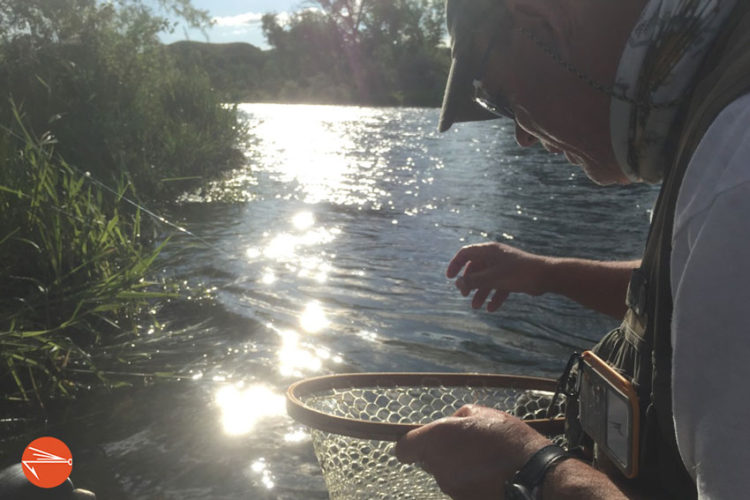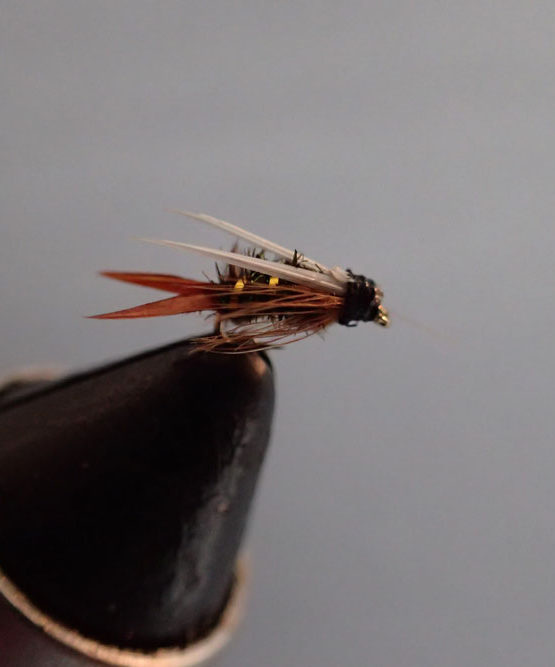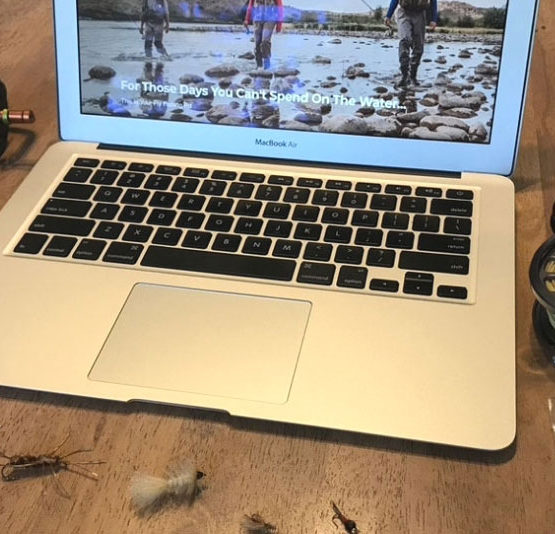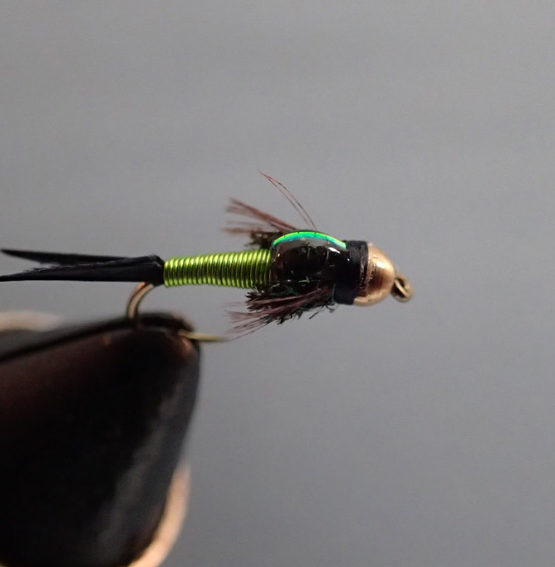A fly fishing net is one of the most essential pieces of equipment you can carry as an angler. However, since nets come in a wide array of shapes, lengths and configurations, toting them around, and keeping them readily available for the moment of truth, can be problematic. So, before we go much further, allow me to answer the big question: what’s the best way to carry a fly fishing net?
The best way to carry a fly fishing net is to connect it to a magnetic net release, (or magnetic net retractor as they’re often called), on the back of your fishing vest or sling-pack. Carrying your net this way keeps it clear of your cast and quickly available when it’s time to net a fish.
And though the dangle-from-the-back-of-your-vest method described above is probably the most common net-carrying system among fly fishers, different angler preferences and fly fishing situations demand different net types and, thus, different net-toting modus operandi.
So, in this post, we will cover the best net-carrying methods for most fly fishing situations.
Let’s get rolling.
Disclaimer: This post may contain affiliate links, meaning we will receive a small commission (at no cost to you) if you click through and make a purchase.How To Carry A Fly Fishing Net
Fishing and nets have gone hand-in-hand since the dawn of time.
In fact, a little-known legend holds that, while managing the Garden of Eden, Adam and Eve spent much of their leisure time fly fishing. While perfecting the sport, they quickly realized how great it would be if they could come up with a better way to land more of the fish they were catching. Long story short, the fly fishing net was born. But, being naked and all, the two quickly realized that they didn’t have a good way to carry their newly fashioned nets around. As the legend goes, they were working on solving this problem when… well… let’s just say that they got a little sidetracked.
With that as our historic backdrop, here are the most common fly fishing net-carrying methods:
1. Dangled From The Back Of The Vest — Handle Up
Many millennia after the Garden of Eden account, net manufacturers finally got together with vest manufacturers and decided to devise a built-in vest loop to which nets could be connected and, from which, conveniently dangled and accessed.
With the help of ingenious, yet simple, magnetic net release, this produced the dangle-off-the-back net-carrying system. Because it freed up the fly fisher’s hands, kept the net out of the way of the angler’s cast, and made it easily available for netting fish, it became the most widely-adopted way to carry one’s fly fishing net.
2. Dangled From The Back Of The Vest — Handle Down
This variation of net-carrying method #1 only differs in the position of the net, which orients with the curved apex of the net skyward, with the handle hanging down, untethered. I suppose the idea here is to make it easier for the angler to reach the handle, but I’ve never liked the idea of having the business end of the net being the part that is connected to the net release or retracting cord. Although many anglers prefer this way, it feels awkward to me, so I’ve always gone with the handle up orientation. The good news is that it’s always up to you and what you prefer. There are very few hard and fast rules in fly fishing.
Additional note on method #2: “Awkward” comment above notwithstanding, net-carrying method #2 does minimize one vexing problem many fly fishers have experienced. For those of us who prefer a net retractor over a magnetic net release system, there is one drawback. This tends to occur when, while bushwhacking through willows or trees, your net quietly hooks up on a passing branch or bramble. As you keep going, it doesn’t. Since the uncoiling retractor is quiet and smooth, you don’t feel it until it’s too late. That’s when your now fully-extended retractor cord reaches its breaking point and twangs away with an unmistakable sound and feeling. This only lets you know that it’s time to buy a new retractor and that, absent a handy replacement, it’s going to be a long day schlepping your net around the old fashioned way.
3. In Your Wading Belt Or Net Holster
Net carrying methods 1 and 2 lend themselves to situations wherein shorter, smaller-bore nets are preferred. These include your most common scenarios, such as smaller streams or rivers wherein huge fish are not generally expected. Although it’s always fun to have a fish on that you know is going to be too big for your net, it’s better to be carrying one that’s designed for the task. So, when fishing a river, pond or lake that is known to host hogs, you better be prepared with a sturdy, large-bore, long-handled “landing” net (like this one from Fishpond).
That said, I don’t know many anglers who love hanging a long landing net from their vest-hooked net release.
Instead, when fly fishing for larger prey, many prefer to simply shove their longer net, handle first, through their back section of their wading belt. One problem with this method is that, unanchored, the longer landing net tends to sag to one side or the other. This is not only annoying, it can get in the way of your cast, exacerbate back pain and/or create chafing friction at the angler’s waist. It can also add extra wear against what is probably an expensive pair of waders. And who has time for that?!
Thankfully, as fly fishing inventors are quick to identify needs to fill with spiffy new gadgets, enter the aptly-named net holster (like this one by Smith Creek). Constructed from thick leather, sturdy nylon or a combination of such materials, net holsters attach to your belt with clips or by threading your belt through. From there, you can slide your holster around to position it wherever you want. However, for obvious and cringe-worthy reasons, I’d avoid a frontal holster location.
We also like net holsters because they make it easy to carry more than one net, if you so choose. Technically, you could hang old faithful from your vest, and tuck a couple extras into additional net holsters. So equipped, you’d have a net for all situations. Might be a little difficult to sit down, and you’d undoubtedly endure a lot of ridicule, but you’d sure be ready for anything!
One last note on the holster. Even though net holsters are a great way to carry your fly fishing net, it’s still a good idea to make sure it’s tethered to the holster or your belt in some way. It’s no fun to see your good net sink or float away because you failed to secure it.
4. How To Carry A Fly Fishing Net When Wearing A Lanyard, Hip Pack or Sling Pack.
Call me a traditionalist, but I didn’t like when we went from a real Christmas tree to a fake one. I was apoplectic when my favorite college and pro football teams ditched real grass fields for astroturf. And when I heard The Masters was going to be played in November instead of April this year, my whole world nearly wobbled off its axle. With that in mind, it’s not hard to understand why I stick to my trusty fishing vest.
I have yet to try a sling pack, but I’ve tried lanyards, backpacks and hip packs, and always go right back to my vest. But that’s me. It may not be you. You may prefer less cumbersome gear-carrying methods. But, if you do, it’s important to know how you plan to carry your net. While many of the more thoughtfully-designed packs, (for instance, the Orvis Waterproof Sling Pack) make provision for a net, quite a few, though usually adorned with many other great features, don’t.
Lanyards and hip packs typically don’t do a good job of it either.
So, for you hip pack, sling pack, and lanyard-wearing mavericks out there, we believe the best way to carry your net is with a net holster threaded through either your wading belt or, if wet wading, your regular belt.
Netting It Out
Despite my rapidly accelerating age, it still seems like just yesterday when my brother and I would grab our fly rods, throw on our old, poorly-equipped vests, and hit some nearby beaver ponds or small mountain streams in pursuit of ten inch Brookies. Since we landed most of them with our hands to then take home and eat, carrying nets wasn’t even a thought.
That all changed when bigger water (and bigger fish) became the norm. I only had to lose one monster to “net negligence” — read “The All Out Attack Take” section in this post — to never find myself without one again.
Even if you’re a fly fishing beginner, invest in a good net or two (just in case, we’ve included a couple links to our favorite nets at the bottom of this post), make sure you employ the best net-carrying methods and certainly don’t leave your net in your truck. If you do, Murphy’s Law clearly states that you’ll hook up on the biggest fish of your life. And while that sounds awesome, just try to land it without a good net. If you don’t believe me, just ask Adam or Eve.
Tight Lines!
Products Mentioned In This Post:
- Orvis Waterproof Sling Pack (If you aren’t a vest-wearing kind of angler)
- Smith Creek Net Holster (A better alternative to jamming your net into your wading belt)
- Fishpond Magnetic Net Release (In our opinion, this is the #1 magnetic net release on the market)
Recommended Nets:
- Fishpond Nomad Hand Net (#1 Hand Net To Hang From The Back Of Your Vest/Pack)
- Fishpond Nomad El Jefe Net (#1 Landing Net To Carry In Your Wading Belt Or Net Holster)










